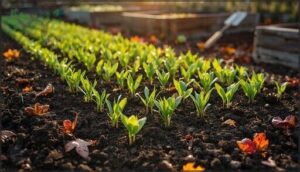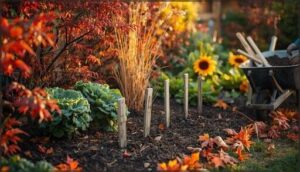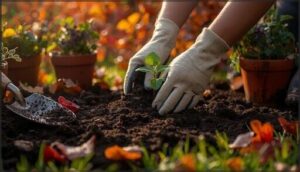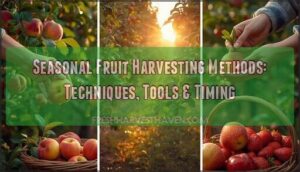This site is supported by our readers. We may earn a commission, at no cost to you, if you purchase through links.
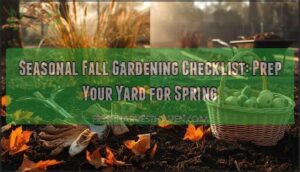
The smartest gardening work happens when most people think the season’s over. While your neighbors pack away their tools at the first hint of cooler weather, you can turn those crisp autumn days into a strategic advantage that pays dividends next spring.
Fall isn’t just about cleaning up—it’s your chance to set the stage for healthier soil, thicker lawns, and more vibrant blooms when winter finally loosens its grip. A well-executed seasonal fall gardening checklist addresses everything from aerating compacted soil to storing tender bulbs, and each task builds the foundation for a yard that wakes up stronger.
Let’s walk through the essential autumn preparations that separate thriving gardens from those that merely survive.
Table Of Contents
Key Takeaways
- Fall lawn care—aerating, overseeding, and raising mower blades to 2.5–3 inches—strengthens root systems and can reduce irrigation needs by 30% while preparing grass for healthier spring growth.
- Amending garden beds with 2 inches of compost worked into the top 8–12 inches boosts water infiltration by 125% and cuts synthetic fertilizer needs by 75%, building soil health that carries into the next season.
- Removing diseased plant debris and disinfecting tools in a 10% bleach solution prevents up to 80% of common pathogens from overwintering, reducing spring disease outbreaks by 25–40%.
- Planting spring-blooming bulbs between late September and October, paired strategically with perennials, extends color displays and attracts nearly three times more beneficial insects while reducing maintenance work.
Essential Fall Lawn Care Tasks
Your lawn takes a beating all summer long, and fall is your chance to give it the care it needs before winter hits. A few targeted tasks now will help your grass bounce back healthier and greener come spring.
Let’s walk through the most important steps to get your lawn ready for the cold months ahead.
Raking and Managing Fallen Leaves
When dealing with fallen leaves, you don’t have to send them off to municipal waste facilities. Instead, mulch them in place using your mower—this returns nutrients to the soil and aids wildlife habitat during winter. Multiple passes break leaves down faster, boosting decomposition rates.
If you prefer composting methods, pile leaves separately for spring use, avoiding leaf removal that depletes organic matter. By adopting a leaf cycling process, gardeners can greatly improve soil quality and biodiversity.
Aerating and Overseeding Lawns
After mulching or composting leaves, turn your attention to aerating and overseeding lawns—a cornerstone of fall lawn care. Aeration breaks up soil compaction, improves water absorption by 50%, and permits deeper root growth. Fall gardening timing is ideal for renovating lawns and reseeding bare spots.
Pair aeration with proper seed selection, a consistent watering schedule, and thatch control. Overseeding increases density and enhances the lawn’s overall appearance. Professional services average $140, though cost analysis varies by lawn size.
Raising Mower Blades for Winter
Once you’ve improved soil density through overseeding, adjust your mower blade height before winter arrives. Raise blades to 2.5–3 inches to strengthen root systems and boost winter grass health. This simple mowing height impact delivers environmental benefits: 30% less irrigation need and better soil insulation. Northern regions should complete final cuts by early November, while southern lawns often wait until mid-December—timing matters for long-term resilience in your fall lawn care routine.
- Set blades between 2.5 and 3 inches for best winter protection
- Avoid cutting more than one-third of grass height per session
- Time your final mow about one week before the first frost
- Gradually raise blade settings to prevent plant shock
Fall Weed Control and Removal
After setting your mower to the right height, don’t let weeds sneak in and undermine your prep work. Fall weed control targets dandelions, henbit, and chickweed before frost hits. Herbicide timing matters most—apply systemic treatments between early October and mid-November for over 80% control.
Mechanical removal works well on small annuals, but you’ll need integrated strategies and resistance management to handle tougher perennials. Weed identification helps you choose between leaf removal, weeding by hand, or chemical options—especially when managing rainy season weeds that thrive in moist soil.
| Weed Type | Best Control Method |
|---|---|
| Dandelion | Systemic herbicide (2,4-D) in fall |
| Henbit | Early fall herbicide or mowing |
| Chickweed | Hand-pulling or targeted spray |
| White Clover | Broadleaf herbicide application |
| Marestail | Metribuzin plus tillage |
Preparing Sod and Seeding Bare Patches
Before laying sod or reseeding bare spots, work 2 to 4 inches of organic matter into your soil to boost establishment success. Aim for 5 to 10 pounds of seed per 1,000 square feet during September’s ideal window.
Keep soil lightly moist daily until roots take hold. This soil preparation and careful watering will renovate your lawn and support strong post-establishment growth.
Preparing Garden Beds for Winter
Getting your garden beds ready for winter doesn’t have to feel like a chore. A little effort now protects your soil, reduces pest problems, and sets you up for a healthier spring garden.
Here’s what you need to tackle before the first hard freeze arrives.
Cleaning Up Annuals and Spent Plants
Once frost hits, it’s time to tackle annual removal and clear out spent plants from your beds. Removing annuals within two weeks of the first hard freeze cuts overwintering pests by 65%.
Sort healthy debris for composting practices, but dispose of diseased foliage separately to boost disease prevention.
This simple step in your fall garden checklist delivers major pest reduction and sets you up for a healthier spring.
Amending Soil With Compost or Organic Matter
After clearing spent plants, focus on amending garden soil with compost—your best move for lasting soil health. Spreading 2 inches of compost and working it into the top 8–12 inches boosts soil structure and drives nutrient cycling into spring.
Here’s what soil amendment delivers:
- 60% increase in organic matter within one year
- 125% improvement in water infiltration for erosion control
- 75% reduction in synthetic fertilizer needs
That application dosage transforms soil fertility and sets up your beds for serious success. Compost benefits go beyond feeding plants—they rebuild the entire underground ecosystem.
Mulching Perennials and Bare Soil
Once your compost is worked in, spread 4–6 inches of pine bark or wood chips over perennials and bare soil. This mulch depth stabilizes soil temperature fluctuations, cuts weed suppression needs by up to 70%, and boosts moisture retention by 25%.
Wait until after the first hard freeze—timing matters for winter protection and preventing root damage from temperature swings.
Planting Cover Crops to Enrich Soil
Cover crops act as a living blanket for empty beds, building organic matter and preventing erosion while you rest. Sow your chosen seeds between August 15 and October 10 to guarantee establishment before frost hits.
- Winter rye develops extensive root systems that break up compacted soil
- Crimson clover and hairy vetch add significant nitrogen through decomposition
- Mixed-species plantings boost microbial diversity and nutrient cycling
- Overwintering varieties reduce erosion by approximately 40%
Removing Diseased or Pest-Ridden Debris
Infected plants left in the garden can shelter up to 80% of common pathogens through winter, setting you up for spring disappointment. Remove and bag diseased debris for municipal composting—home piles rarely get hot enough to kill fungi and bacteria. Disinfect your tools in a 10% bleach solution for 30 minutes to prevent cross-contamination.
Remove diseased debris and disinfect tools in bleach solution to stop 80% of pathogens from overwintering in your garden
| Disposal Method | Effectiveness |
|---|---|
| Municipal composting | Destroys most pathogens through high heat |
| Burning (where legal) | Sterilizes infected material completely |
| Burying 2+ inches deep | Accelerates decomposition, limits pest access |
This fall gardening step reduces disease outbreaks by 25–40% and pest pressure by up to 67% next season.
Perennial and Vegetable Garden Maintenance
Your perennial and vegetable beds need some attention before winter settles in, and fall is the perfect time to tackle these tasks. A few smart moves now will keep your plants healthier and give you a head start on next year’s growing season.
Here’s what to focus on in your beds this fall.
Lifting and Dividing Overgrown Perennials
When perennial plants outgrow their space, fall gardening tips suggest dividing them four to six weeks before frost. This technique boosts disease prevention by improving airflow and can increase bloom production by 30–40%.
Lift overgrown perennials carefully, keeping at least three growing points per division for 85% survival. Root health improves, propagation gains multiply your stock, and technique success depends on consistent watering afterward.
Digging and Storing Tender Bulbs
After dividing perennials, turn your attention to tender bulbs like dahlias and gladiolus that won’t survive freezing ground. Digging timing matters—wait until the first killing frost browns the foliage, then dig within a few days to minimize rot risk.
Here’s your storage roadmap:
- Cure bulbs 1–3 weeks at 60–70°F in dry, ventilated shade
- Choose storage media like peat moss or vermiculite in 2–3 inch layers
- Select containers with airflow—paper bags work perfectly
- Maintain overwintering temperatures between 40–50°F in unheated spaces
- Check every 2–3 weeks for rot or shriveling during winter monitoring
Proper curing process and storage conditions mean healthy spring blooming bulbs.
Pruning Trees, Shrubs, and Perennials
Once your bulbs are safely tucked away, pruning trees, shrubs, and perennials becomes your next priority. Focus on removing dead or diseased stems now—cutting back infected perennials like phlox or bee balm reduces overwintering pests by up to 65%.
For shrubs, don’t remove more than 33% annually to avoid stress. Save major tree pruning for late winter when wound healing peaks and cold hardiness isn’t compromised.
Adding Mulch to Vegetable and Flower Beds
After pruning, spread 2–3 inches of organic mulch over your vegetable and flower beds. This simple step retains up to 70% more moisture and suppresses 95% of weed growth through winter. You’ll also cut disease risk by 60% while protecting roots from temperature swings.
Wait until beds are cleared of debris, then apply your mulch evenly for maximum soil health benefits.
Expanding or Creating New Planting Areas
Fall’s the perfect time to expand your growing space since warm soil encourages root growth while cool air reduces plant stress. Here’s how to prepare new garden beds that’ll thrive come spring:
- Choose a site with full sun and good drainage to cut disease risks
- Build raised beds 6–12 inches high for better visibility and drainage
- Work 4 inches of compost 12 inches deep to improve soil structure
- Apply phosphorus, potassium, and lime based on soil test results
- Mark and loosen soil before planting to support healthy root development
Proper site selection and soil amendment now means nutrient management pays off when you’re ready to plant.
Fall Planting and Propagation
Fall isn’t just about cleanup—it’s one of the best times to set next year’s garden in motion. The cool soil and reliable moisture give new plants a head start that spring planting can’t match.
Here’s what to plant and propagate now to give your garden a jumpstart come spring.
Planting Spring-Blooming Bulbs
Late September through October is your window for planting spring blooming bulbs before the ground freezes. Set tulips and daffodils at depths two to three times their height—usually four to six inches—in well-draining soil to avoid rot.
Choose varieties that bloom at different times for extended color, and control pests like aphids early. This autumn gardening step ensures vibrant displays when winter retreats.
Installing New Trees and Shrubs
Aim to plant trees and shrubs at least six weeks before your first hard frost to support root establishment. Choose species suited to your zone, position them at the right depth, and follow a consistent watering schedule—about one inch per week until the ground freezes.
Apply mulch around the base to insulate roots, and protect young trunks from deer and winter sun with guards or wraps.
Pairing Bulbs With Perennials
Weaving spring-flowering bulbs into your perennial beds sets you up for extended color and less work. Plant tulips, daffodils, or allium among hosta or salvia this fall, and you’ll enjoy bloom time extension through late spring while the perennials hide fading bulb foliage.
- Weed suppression: Dense ground cover cuts manual weeding by 34%
- Pollinator support: Mixed beds attract nearly three times more beneficial insects
- Planting techniques: Space bulbs 10–12 inches from perennial crowns and plant at two to three times bulb diameter
- Maintenance longevity: Bulbs paired with perennials flower for 3–5 years versus just 2 in monoculture
Collecting and Saving Seeds
Ever wondered how saving seeds from plants can shape next year’s garden? Start by choosing disease-free species with high seed viability. Collect seeds as pods begin to split, then clean thoroughly to control contaminants.
Dry and store seeds in airtight containers, keeping moisture low. Labeling seeds—species, date, and location—makes future planting easier and helps track performance over time.
Taking Cuttings for Indoor Propagation
Fall gardening offers a perfect window for taking cuttings to grow indoors. Select semi-hardwood or softwood stems from healthy plants like pothos or coleus.
Rooting hormones boost success rates by 90–130%, while proper media moisture and indirect light requirements guarantee strong development.
After 6–12 weeks, gradually introduce acclimatization before transplanting. This plant propagation method turns one thriving specimen into many for next season’s garden.
Tool Care and Garden Cleanup Routine
Once the beds are cleaned and plants are tucked in, it’s time to turn your attention to the tools that got you through the season. Proper care now means your equipment will be ready to perform when spring rolls around.
Here’s how to wrap up your fall routine with a few practical maintenance steps.
Cleaning and Storing Garden Tools
Before you hang up your tools for winter, give them the attention they deserve. Cleaning garden tools after each use cuts disease transmission by up to 90%. Scrub off soil with soapy water, then disinfect blades with a 10% bleach solution.
Dry thoroughly—air-drying reduces rust by 80%. Apply a light oil coat for rust prevention, then store in a dry space below 60% humidity.
Draining and Storing Hoses and Irrigation Systems
Just as clean tools resist rust, properly drained hoses and irrigation systems dodge freeze damage costs that can hit $500 or more per valve. Disconnect your garden irrigation from outdoor faucets once temperatures dip below 40°F. Raise one hose end to drain completely—this simple step prevents 90% of burst incidents.
For drip irrigation systems and irrigation tubing, use pressurized air at 40–80 psi to clear underground lines. Turn off irrigation system controls, then store hoses coiled loosely indoors.
Proper hose storage and maintenance inspection protocols extend equipment life by 30% while protecting your investment through winter’s harsh freeze-thaw cycles.
Sharpening Blades and Servicing Equipment
Beyond protecting hoses, your pruners and mower blades need attention too. Blade sharpening frequency matters—pros sharpen weekly during peak season, but home gardeners should aim for every 25 hours of use. Sharp equipment safety impact is real: dull blades tear plant tissue and increase injury risk by 18%.
Clean hand tools, then sharpen pruners to 10–25 degrees and hoes to 30–35 degrees.
For preparing small engines, drain gas lines and change oil before storage. These servicing best practices boost cutting efficiency 30–50% and extend tool life 27%, delivering maintenance measurable outcomes you’ll see next spring.
Organizing Stakes, Labels, and Accessories
Once your blades are sharp, turn your attention to those stakes, tags, and markers you’ve scattered around all season. Vertical tool racks and modular organizers with labeled compartments cut search time by 30%, giving you efficient garden workflow when spring arrives.
Store stakes in waterproof containers to avoid rust—you’ll reduce replacement costs by 30%. Clean weatherproof labels and group them by plant type to boost identification accuracy 25%.
Composting Leaves and Garden Waste
After you’ve tidied up stakes and labels, turn those piles of fallen leaves into garden gold. Add garden waste to your compost and watch soil enrichment happen naturally:
- Layer two to three times more browns (dry leaves) than greens for ideal leaf decomposition
- Shred material first to speed breakdown
- Cover scraps with four to eight inches of leaves
- Turn regularly until your pile shrinks to one-third its size
Composting fallen leaves diverts waste from landfills and improves soil nitrogen, phosphorus, and potassium—delivering clear compost benefits while reducing greenhouse gases by over 50%.
Frequently Asked Questions (FAQs)
How often should I water my garden in fall?
Like a thermostat adjusting to cooler temperatures, fall gardening requires reducing irrigation times. You’ll usually water once weekly, checking soil moisture two inches down.
Adjust watering frequency based on weather influence, plant type, and disease prevention needs.
When should I apply fall lawn fertilizer?
Apply fall lawn fertilizer between late September and early November, ideally when soil temperatures stay between 50°F and 65°F. Time it two to three weeks before the ground freezes for best nutrient absorption.
Can I plant vegetables in the fall season?
You can plant fall vegetable crops like kale, lettuce, and broccoli. Cool temperatures reduce pest pressure by 30–50% while boosting flavor.
Plan succession planting for continuous harvests in your cold-hardy vegetable garden through early winter.
Should I cover outdoor containers before winter arrives?
Yes, you should cover outdoor containers before winter arrives. Insulation with burlap or frost cloth can increase plant survival rates to 75–85%, protecting roots from freeze damage and preventing container cracks.
How do I protect plants from early frost?
When temperatures dip near 28°F, cover frost-sensitive plants with lightweight cloth before sunset to trap heat. Water soil beforehand to increase warmth retention, and choose frost-tolerant varieties for future seasons.
Conclusion
The garden that sleeps best in winter wakes strongest in spring. Your seasonal fall gardening checklist isn’t about ending the growing season—it’s about beginning the next one with intention.
Every leaf raked, every bulb planted, and every bed amended compounds into resilience you’ll witness come April. The work you finish now determines whether you’ll chase problems next year or simply enjoy the blooms.
Invest these autumn hours wisely, and your yard will return the favor tenfold.
- https://stacyling.com/planting-next-years-garden-in-fall/
- https://www.farmprogress.com/insects/fall-practices-to-reduce-next-year-s-pests
- https://melissaknorris.com/podcast/podcast-38-fall-gardening-prep-10-tips-improve-soil/
- https://www.meadowsfarms.com/blog/benefits-of-fall-gardening/
- https://www.gardenary.com/blog/when-should-i-start-my-fall-garden




